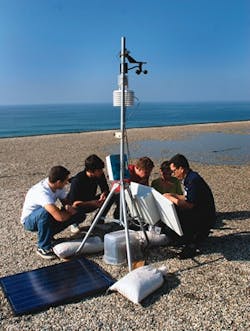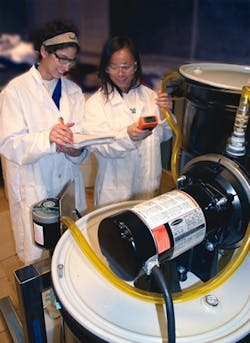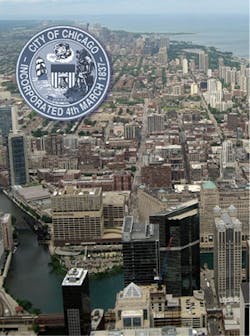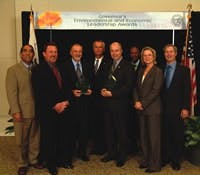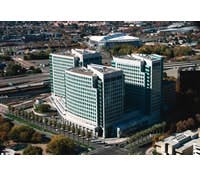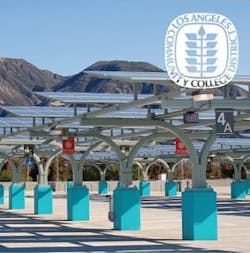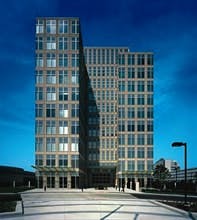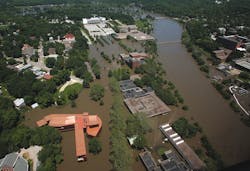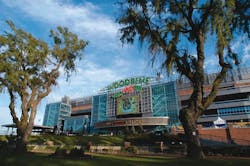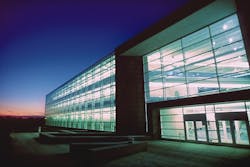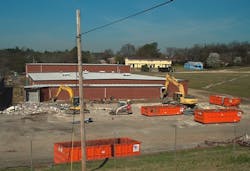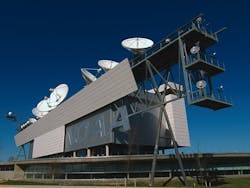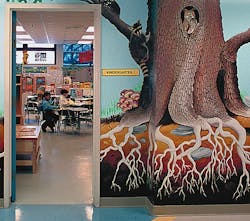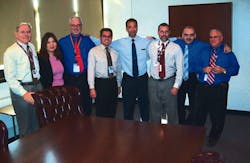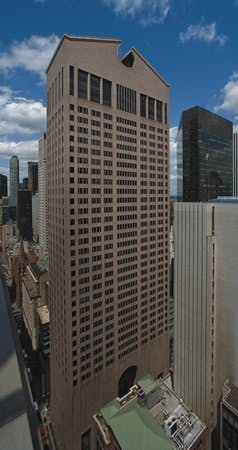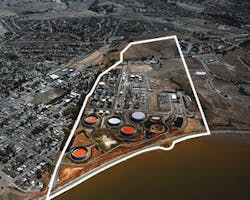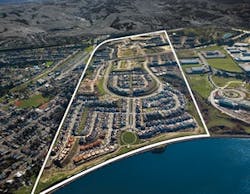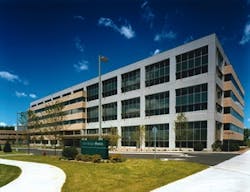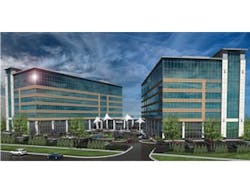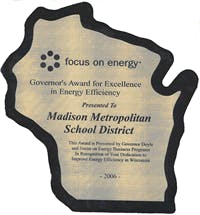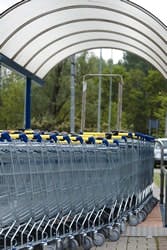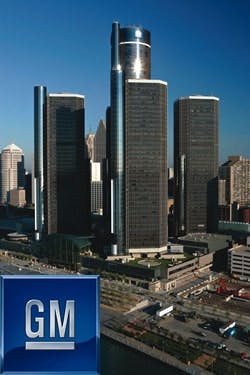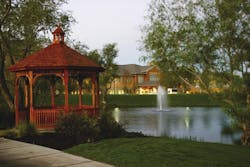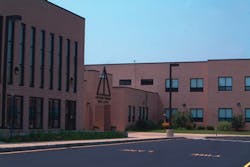Who’s Who in the Buildings Market 2008
The editors of Buildings have handpicked 44 organizations and departments that are getting things done—slashing energy costs, improving customer service, building with the end-user in mind, investing heavily in employee training and development, etc.—in truly remarkable ways.
Take note: These companies and teams don't just survive—they thrive.
Editorial Director Linda K. Monroe
Managing Editor Jana J. Madsen
Senior Associate Editor Leah B. Garris
Companies Featured (in alphabetical order):
1
CB Richard Ellis
[Los Angeles, CA]
In mid-2007, CB Richard Ellis (CBRE) announced its goal of becoming a carbon-neutral company by 2010, and it was the first major commercial real estate services company to do so. Along with this announcement also came a plan for helping its clients, located in 1.7 billion square feet of space around the world, with energy-efficiency programs. While this proclamation is deserving of recognition, it's the way in which the organization is achieving this goal that's really worth mentioning. CBRE is doing things the right way—taking a close look at in-house and client processes first to identify areas that need improvement.
CBRE has introduced a notable array of programs for the buildings it manages:
- An innovative recycling pilot program for office buildings.
- BOMA's Energy Efficiency Program (BEEP) and 7-Point Challenge.
- Green Knights, a nationwide team of CBRE employees who serve as sustainability advocates.
- "101 Tips for Successful Sustainability," a proprietary list based on the USGBC's LEED-EB rating system—but with a twist.
- A 12-step Standards of Sustainability program that focuses on low- or no-cost solutions for all managed office assets.
Going green and making sure that occupants are on board is a feat in and of itself, but trying to convince tenants to go green when you're not the one who owns the property is a whole different ballgame. Without a doubt, each client has a different agenda and opinion. CBRE employs a unique way of looking at each tenant and its business processes; then, CBRE does what it can initially to change behaviors and make improvements that don't require lots of upfront money or active owner participation.
With its carbon-neutral goal looming, we're eager to see what the next few years bring for the world's largest commercial real estate services firm. If any organization has the reach to make a difference, it's CBRE.
Why we like them:
The largest commercial real estate firm in the world takes a sustainability stand
First Industrial's intense focus on customer service caught our eye. The company's "2-hour rule" is genius. Every phone call that comes into its offices during normal weekday hours is guaranteed to be returned by a First Industrial team member within 2 hours; if that doesn't happen, the company donates $50 to a charity of the customer's choice. So, it's no wonder that this customer-service focus has resulted in industry-leading tenant satisfaction scores for First Industrial for the seventh year in a row.
Satisfaction at First Industrial isn't limited to its customers, either. In a survey offered to employees last year, administered by an outside company and benchmarked against industry standards, the company learned that 94 percent of its employees have a clear understanding of company goals and objectives, 93 percent understand how department objectives fit into corporate goals, and 84 percent say that the company's management style encourages them to give their best. These survey results translate to happy employees, which translates to— basically—better everything.
The company's green initiative, which was put in place to create new ideas and ways to communicate green activities to the industrial real estate world, has spurred innovation as well. A comprehensive review will evaluate First Industrial's green standing among its peers, and will help it look for growth areas; presentations from green experts will allow First Industrial to understand the cost benefits and risks of green development and operations; an e-mail response box was created for green feedback; and discussion about ways to help the environment has been added to the company newsletter.
Along with First Industrial clients and employees, we're pretty satisfied with the company and its initiatives, too.
Why we like them:
First Industrial puts its tenants first—even if it ends up costing just a little bit more
Situated along the Pacific Ocean on 1,200 acres of coastal woodland, the University of California, San Diego (UC San Diego) is not only a powerful magnet for those seeking a fresh approach to education and real-world research, but also a unique "learning" influence on its 27,500 students and 27,000 employees. UC San Diego partners with local and national organizations, turning projects with local impact into concepts with national and global reach. And, as a leader in climate-change solutions (it's celebrating the 50th anniversary of the first measurement of greenhouse-gas build-up, which was conducted at UC San Diego), the school's Climate Solutions Work Group (CSWG) is overseeing the implementation of more than 4 megawatts of renewable-energy projects. Drawing upon status, brainpower, and financial leverage to help generate power from solar photovoltaic and biogas fuel cells during the day, and wind farms at night, UC San Diego also:
- Operates a high-energy, ultra-low-emissions, 27-megawatt combined-cycle power plant that makes the university a net importer of electricity.
- Uses a wireless-sensor network to monitor air quality and meteorological conditions on campus via its Decision Making Using Real-Time Observations for Environmental Sustainability project (DEMROES), which provides the FM department with information used by its energy-management system to improve operations, energy efficiency, and irrigation management.
- Supports a student-led Green Campus Program, which promotes campus green building/facility operations, as well as campus-wide sustainability initiatives, such as energy competitions between residence halls (which resulted in a 20-percent reduction in energy use).
Although UC San Diego is fortunate to have the support and expertise of its forward-thinking administration, continuous-improvement practices are only possible when students and faculty are asked—and empowered—to think outside the box while learning the "art" of collaboration. Imagine how these future leaders will influence corporate and political America in the next decade.
Why we like them:
UC San Diego strives to become one of the nation's greenest university campuses
For the fourth time in 8 years, this technology leader, which specializes in defense, Homeland Security, and other government markets throughout the world, received ENERGY STAR® recognition, capping its achievements in April 2008 with the ENERGY STAR Sustained Excellence in Energy Management Award. This world-class energy-conservation effort is largely due to a group of internal energy engineering personnel who have not only retro-commissioned 200-plus buildings, but also deployed tools and metrics to reduce plug load.
▼11.7% ▲ 45% Raytheon has reduced energy consumption by 11.7 percent since 2002, while revenues have risen by 45 percent. |
Conserving energy isn't new at Raytheon. In the past, the focus was on facilities operations: HVAC, lighting, and plant operations. Since most energy consumption is controlled by people, however, it became clear that reducing the company's carbon footprint would require cultural change. Through its participation in the U.S. EPA's Climate Leaders program, Raytheon committed to a 7-year, 33-percent reduction in greenhouse-gas emissions beginning in 2002. By the end of 2007, it achieved a 28-percent reduction toward this goal. In addition, programs like Energy Champions (a network of 600 employees who encourage peers to conserve energy) and Energy Citizens (where personnel are directed to an internal website to learn about and become "certified" on energy-conservation practices) have resulted in an enthusiastic, proactive workplace. This truly innovative corporation has found a way to bring big business down to a more personal level.
Why we like them:
Conserving energy is a cultural change at Raytheon
Mayor Richard M. Daley's commitment to—and methodology in—making the Windy City the most environmentally friendly city in the world is simple: It's not something he—nor city government—can do alone. "Small actions can amount to big change, especially if taken up on a grand scale," he says. The city's Environmental Pledge, which was launched in 2007, uses energy, water, air, land, and waste as focus areas.
Leading by example, the city was one of the first municipalities to green its municipal fleet; next, it directed its focus to owned and leased buildings, as well as to procurement practices. Most importantly, however, Chicago's leadership engaged area real estate trendsetters in comprehending the influence that their own environmental practices would have on the community. Landmark buildings, such as The Merchandise Mart—one of the world's largest commercial buildings—have achieved LEED certification, which is a remarkable accomplishment that would've been deemed nearly impossible just a few years ago.
"You care. Do something. We'll help." is the City of Chicago's slogan. It's inspiring ... and effective.
Why we like them:
Conservation is working for the Windy City
In its 221 offices across 58 countries, the world's largest privately held commercial real estate services firm offers a range of services in four disciplines: transaction services, including tenant and landlord representation in office, industrial, and retail real estate; capital markets, including property sales, investment management, valuation services, investment banking, and debt and equity financing; client solutions, including integrated real estate strategies for large corporations and property owners; and consulting services, including business and real estate consulting.
But, Cushman & Wakefield (C&W) doesn't rest on its laurels: Its "service-and-quality-first" philosophy reaches all business areas. Recent accomplishments include:
- Certification. Globally, 4 million square feet of commercial space have been certified under LEED and Green Star, with an additional 43 million square feet in progress.
- Awards, including the 2007 BOMA Earth Award, CoreNet's 2007 Sustainability Leadership Award, and CoreNet's 2008 Industry Leadership Award.
- Best practices, comprising day-to-day business and internal and global best practices competition, which is judged by a Quality Assurance Council.
What's next for this industry giant? With global interests, it's anyone's guess. What we do know, however, is that it'll be offering its clients the best of all worlds.
Why we like them:
"Full service" means much more at Cushman & Wakefield
Affordable, accessible, and practical, the Los Angeles Community College District (LACCD) offers education and training to more than 133,000 students annually, and serves as a forum for sustainability and positive change. In addition to the LACCD's Renewable Energy Plan (on Earth Day 2008, the district's East LA College powered up its $9 million, 1.2-megawatt solar installation, which is a major component of making all nine campuses energy independent), its Green College Curriculum and Initiative is providing tomorrow's leaders with skills, training, and knowledge to become environmental stewards.
Internally, the district considers its BuildLACCD team unique when compared to other facilities management and development organizations. The following speaks for itself:
- Precedent-setting policies, including a sustainable-building policy that resulted in an aggressive mandate to make all LACCD campuses 100-percent green.
- Willingness to take risks, as evidenced by its design-build approach to growth. Five consecutive projects (four are being fast tracked) at the district's Los Angeles Southwest College will be completed by year end at a cost of $63.5 million.
- Innovative green-building design, where the team will oversee the completion of 44 LEED-certified LACCD buildings and 455 remodeled buildings.
- Solid management, where the district combines its own expertise with URS Corp. as the program-management company overseeing LACCD's building efforts.
What a role model this team is for LACCD's student body. What could be more influential and inspiring than that?
8What's truly extraordinary about the USCG is not just its early adoption of building information modeling (BIM)—it's the way BIM is used in design, construction, and operations; the scale at which it's been implemented; and its use in evaluating building safety during design. In a move that changed it from a building-centric to a portfolio-based organization, the USCG defined goals and set organizing principles. The result: integrated decision-making and the implementation of software tools that combine BIM and a geographic information system (GIS), accessed through its Capital Asset Management Portal (CAMP). BIMs are being created for the entire USCG facility portfolio, and virtual bombs help determine the blast threat and impact of facility design on safety and security.
9You can sum up USAA in just one word: leadership. USAA has long served as a leader for other property/facility management teams to model after, starting with its commitment to sustainability. USAA was green way before it was in vogue. Any time a new green program is rolled out, USAA is there, involved from the very beginning.
The organization has been active in ENERGY STAR® for the better part of a decade, and has helped create new models for improving financial and environmental performance. The company has been awarded the ENERGY STAR Partner of the Year award for 6 straight years due to its leadership in energy management and environmental stewardship. And, as a special coup, the company was chosen to develop the USGBC's LEED Portfolio Program (a program that allows owners to integrate LEED into new and existing buildings, portfolio wide, in a cost-effective way). USAA leadership efforts continue as it participates in the first private-sector pilot of the BOMA Intl./Clinton Climate Initiative Building Retrofit Program. USAA is helping to create a standardized energy-performance contract model whereby energy savings can be used to pay for capital investments in energy-efficiency upgrades.
USAA clients must appreciate everything the organization is doing (and so do we): More than 95 percent of its tenants indicate that they're satisfied, and USAA has had an average tenant-retention rate of 93 percent for the last 10 years.
Watching what USAA does next will be interesting. Wherever this organization is headed, the industry is sure to follow.
Why we like them:
Leading the green charge: USAA does it well
As usual, we were eager to see what the University of Iowa's (UI) facilities management department had been up to. This Big Ten school never ceases to impress us—and they've done so this year, even more than ever.
The UI is going to be busy in 2009. Some of its plans include:
- Creating a system to facilitate a "lessons-learned" investigation of injuries, near-miss incidents, and workplace hazards. The system will help users automatically share safety solutions with the entire organization.
- A comprehensive study of custodial-service standards to ensure consistent service levels, reveal areas in which custodians are over- or under-challenged, facilitate requests for higher-level cleaning standards, expose training needs and opportunities, etc.
- Implementation of a self-serve system to assist UI employees in scoping the work and procuring contracted services for routine painting, carpet, and furniture improvements.
- A new document-management system that will replace old methods of filing/retrieving documents.
- Establishing an Office of Sustainability.
This past year, the UI created an energy and engineering department. It's also launching an energy control center to improve data collection and facilitate HVAC scheduling, optimization, and troubleshooting. It's all about streamlining operations at the University of Iowa.
And, if these things aren't enough to make an impression, consider this: The UI is taking on all of these projects in the midst of major flood-recovery efforts. By the time the Iowa River crested in mid June, the UI was faced with the effects of a 500-year flood. Although 20 major campus buildings were flooded, the UI managed to save much more than it lost. We're fascinated by the things this forward-moving FM team continues to accomplish, even when confronted with vast trials. (Stay tuned for more about the UI's flood-recovery story, coming in our November issue.)
Why we like them:
The University of Iowa's FM team never slows down, even when flood clean-up stands in its way
Woodbine Entertainment Group (WEG), recognized for its horse-racing operations, is on the fast track to environmental stewardship and smaller energy bills. Two years ago, WEG partnered with a local utility to save energy and reduce greenhouse-gas emissions. The 3-year program is paying off big, and WEG estimates annual energy savings of $475,000.
Reducing power is just one of many initiatives on WEG's long list of impressive stewardship actions. Regular waste audits have resulted in a commitment to recycle nearly everything at the track—paper, wood, fluorescent lamps, metal, used tires and straw, manure, plastic, grease, cardboard, glass, and even betting tickets. Each year, approximately 1,200 tons of material are being diverted from landfills to recycle streams. Water conservation isn't overlooked, either: Its stormwater ponds are reducing demand on the municipal water system by recycling approximately 11.4 million gallons of water annually.
12Recognized as the cornerstone of this full-service commercial real estate and development firm, Transwestern's property-management team manages a 600-property portfolio totaling more than 130 million square feet. The true testament to its success: Its clients have been with the company for more than 20 years. Why?
Transwestern's leadership role in protecting the environment stems from a deep commitment to doing the right thing, as well as a long-term approach to business—and clients recognize that. At the core is its long-term interest in energy efficiency, which came as a result of the 1999 California energy crisis. Transwestern's 5-year recognition by the U.S. EPA as an ENERGY STAR Partner of the Year (2004 and 2005) and as a Sustained Excellence Award Winner (2006, 2007, and 2008) for its outstanding contribution to reducing greenhouse-gas emissions through leadership in energy management are proof that the organization is headed in the right direction.
What truly sets Transwestern apart in this arena, though, is its recognition of the building operations team. In 2007, it was one of the first to commit to BOMA Intl.'s 7-Point Challenge to reduce the industry's use of natural resources, dependence on non-renewable energy sources, and waste production by 30 percent when compared to an industry average. Already, the company has met this noteworthy goal—a measurable action brought about by the significant training, commitment, and expertise of the operations teams.
Why we like them:
Transwestern meets—and surpasses—its own energy-management expectations
Aging facilities, skyrocketing energy prices, and flat operating and maintenance budgets are enough to slow any facilities management team down. But, Southern Illinois University Edwardsville's (SIUE) team continues to overcome these challenges.
With its recent 50th anniversary, SIUE has much to celebrate: a significant growth in student population, the successful transition from a commuter campus to a residential campus, etc. But, as the FM team can tell you, along with a 50-year anniversary comes challenges: Retrofits are becoming pressing. To address these issues, a plan—developed by the FM department—was presented to students. The plan asked students to approve a student fee to help maintain buildings. The fee was approved, and plans are in place to upgrade on a pay-as-you-go basis.
Energy usage at SIUE is also being tackled with this same innovative attitude and rethinking. The central campus heating plant has been abandoned; a change to high-efficiency boilers in individual buildings has resulted in a 21-percent reduction in natural-gas usage. The central chiller plant has been converted to a high-efficiency electric chiller with thermal storage to improve electrical load factor, reduce the overall electric rate, and reduce source energy consumption by one-half. All loads requiring chilled water in the winter have been identified and eliminated, allowing the central chilled water plant to shut down for several months each year.
14Through macro- and micro-level benchmarking, Food Lion has reduced its energy use by more than 2.29 trillion BTUs, and is the first supermarket to be named ENERGY STAR Partner for 6 years in a row. On a large scale, Food Lion makes use of the EPA's Portfolio Manager to benchmark energy use. Metrics are tied to evaluations and bonuses, sparking motivation. Energy specialists are sent to any store that doesn't receive an ENERGY STAR designation. On a smaller scale, Food Lion uses sub-metering to monitor system energy consumption. This sub-metering can also track the energy being used in certain areas of the store, like the deli.
The organization takes time to promote energy-saving practices with its staff, too. In a 1-month period, energy usage in 20 Food Lion stores was reduced by more than 8 percent simply by teaching deli employees about when they should be turning on their equipment. That's a smart, no-cost way to achieve big savings—and big respect.
15The Bibb County School District is in the midst of a capital construction program that's providing a rare opportunity to design and construct facilities unlike the district ever has before. As Bibb County works on these projects, it's going beyond the typical school finishes and exploring other options for the high-performance buildings being constructed. One example: Instead of VCT flooring, which requires a lot of maintenance and is used in many budget-challenged public schools, Bibb County is using surface-seeded polished concrete. This investment requires more money upfront, but will give the district a 2- to 3-year payback on maintenance costs. Smart move.
With new building projects like these comes the responsibility of dealing with the existing facilities. When it's time to redevelop older sites, the district chooses "deconstruction" over demolition. Usable items from the old buildings are saved and sold vs. going to a landfill. In the case of one old school building, systems were sent to Haiti to rebuild schools that were lost in a hurricane. Concrete, brick, and asphalt were ground into aggregate and reused as a base for roads and parking, and as underlayment for pipes.
Incorporating a "use-the-building-as-a- teaching-tool" concept into its facility designs, the district views some of its investments as having multiple benefits. A rainwater-harvesting system is currently under investigation not only for water conservation, but also to be used as a teaching opportunity. Something tells us that Bibb County students won't be the only ones to learn valuable lessons as a result of what this school district is accomplishing.
16Most property management firms agree that their most valuable resource is their employees. But, Dominium—a Minneapolis-based owner, developer, and manager of apartment communities—proves it by investing heavily in employee development and education. The philosophy? Better training and development creates a better staff. This way of thinking is what led to the creation of Dominium University, a training program that offers intro classes for newly hired or promoted property managers, and advanced classes to experienced property managers. What makes Dominium's program even more unique is that it lets its successful managers—from the VP of human resources to the VP of property management—pass knowledge on to new and up-and-coming managers. The training courses are written for Dominium employees by Dominium's very best leaders. The "university" is broken up into different schools: principles of property management, marketing and sales, legal basics, accounting compliance, maintenance, etc.
More than just lectures, Dominium University classes offer exercises and mock situations to put property managers in real-life situations; modern labs allow property managers to work on recreated maintenance problems. With each employee receiving similar training, consistent and reliable performance and management practices can be counted on. What a unique way to show your employees that you care about their growth and success—and ensure that your tenants receive top-notch service.
Why we like them:
Putting its money where its mouth is, Dominium directs attention and effort to training
While big doesn't always mean better, it's hard to ignore the impact that the United States' largest landlord has when it adopts cutting-edge technology and sustainable design. All of the U.S. General Services Administration's (GSA) new buildings are built to achieve LEED certification. As of June, 25 have been certified; 70 more are registered. And, while other people were busy talking about natural ventilation and daylighting, the GSA's Public Buildings Service (PBS) was incorporating it into the San Francisco Federal Building.
Since 1994, the GSA has engaged top-quality design professionals with its Design Excellence Program. The program is significant.
Discussion of the GSA's approach to design and construction wouldn't be complete without mention of its support for 3-D/4-D building information modeling (BIM). The PBS Office of Chief Architect is assessing and supporting 3-D/4-D BIM applications in more than 35 ongoing projects across the nation. The GSA stuck its neck out when it adopted BIM in 2003; today, it's reaping rewards just as big as the risk.
18With their compact fluorescent lamps and linen-reuse programs, tons of hotel chains claim to be environmentally friendly—but no other lodging company takes green as far as Marriott Intl. Its five-point environmental strategy calls for:
- The reduction of water, waste, and energy consumption.
- The greening of its supply chain.
- Building green hotels.
- Rainforest preservation.
- Engaging employees and guests to take action.
Green hotel construction guidelines are currently in the works; by the end of 2009, they'll be rolled out for use on new hotel projects. In early 2008, Marriott's headquarters implemented an aggressive recycling and composting program; the result is a waste-neutral facility.
Marriott is working to reduce its worldwide carbon footprint of 2.9 million metric tons of CO2 emissions annually, and is on track to reduce greenhouse-gas emissions by nearly 1 million cubic tons by 2010. By 2017, Marriott strives to cut energy consumption by 25 percent. It currently boasts more than 250 ENERGY STAR hotels—more than any other lodging company—and was recently recognized by the U.S. Environmental Protection Agency as an ENERGY STAR Partner of the Year for the fourth consecutive year.
New Haven's Citywide School Construction Program began in 1995. The $1.5 billion initiative is the largest per-capita program in the nation. With more than half of the city's schools already built or renovated, it's well on its way to rebuilding every public school in the city. The 26 schools that have been completed illustrate a commitment to energy efficiency and green-building practices. The program acknowledges the existing school building's place in the neighborhood community and, whenever possible, is refurbishing and expanding them.
Schools are being modernized, retrofitted, redesigned, and constructed to serve the needs of students and their communities well into the future. Examples include flexible room plans at Edgewood Magnet School, core spaces at Clarence Rogers School that can be made available to the community, and the placement of the music room adjacent to the cafeteria (divided by a movable wall) at King/Robinson Magnet School. The belief is that students learn better in good environments. Judging from students' test scores, we think they're right.
20Opus has taken some out-of-the-box ideas to its clients this year, and these ideas have landed the company on our list. Pitching the notion of daytime janitorial to the U.S. EPA during construction of its Region 8 Headquarters, Opus' idea allows the building to be "put to bed" at 6 p.m.—lights go off and the HVAC system is turned down. This early closing time means that the building is "off" for 25 percent of the day, translating to savings of $250,000 per year. This idea sounds great in terms of cost savings, but the other benefits it brings are also worthwhile: light pollution is eliminated due to the 6 p.m. turnoff time, the janitors become part of the building's professional community, top janitors are easily found due to the interest in daytime hours, janitorial requests are addressed immediately, and workplace trust/respect between tenants and janitors is increased because of face-to-face contact.
Opus also focuses on collaboration when it comes to working with tenants. The EPA's Region 8 Headquarters pairs Opus property management with the EPA's facilities manager, and they meet on a weekly basis to discuss best practices and maintenance innovations.
In addition, Opus has created a Green Team, made up of senior property managers and building engineers. The team is focused on identifying the sustainable practices that can be implemented across Opus' portfolio, including low- and no-cost options.
Avant-garde thinking equals a real estate development company that saves its clients time and money, and that's especially out of the box.
Why we like them:
Novel ideas from Opus help its tenants save money—and the environment
With 1,300 sites throughout the five boroughs of the City of New York, the NYC Department of Education's Division of School Facilities (DSF) went in search of a means to collect and report on the state of its facilities. To formalize inspections and gather hard data, the DSF sought help from 10 inspectors as part of its SchoolStat Unit initiative. This independent assessment group conducts periodic, nontechnical, visual inspections of all NYC Department of Education facilities on a quarterly basis. A formal report is generated from numerous data streams, including questionnaire responses, digital images, and the entry of data into computerized tablets. Facilities are scored and can also be compared. The SchoolStat Unit not only provides a uniform assessment of facilities, but also enables analysis of managerial effectiveness and resource allocation. This program raises the awareness of school conditions, pinpoints deficiencies, and fosters competition and pride among the professionals tasked with school-building operations. It provides an unbiased measure of the performance of operations staff and facility conditions, which is a far cry from the anecdotal and disparate perspectives that many school districts rely on to inform decisions about operations, construction, and maintenance staffing.
Why we like them:
The Division of School Facilities finds that regular inspections are key to assessing NYC school conditions
The company's biggest transformation to date came in December 2007, when it merged with NNN Realty Advisors, a commercial real estate management investment firm. The merger added 160 commercial properties to the existing portfolio. The NNN Realty deal resulted in the acquisition of Triple Net Properties, a commercial real estate asset-management firm that specializes in tenant-in-common investment programs. As a result, these acquisitions have taken Grubb & Ellis one step beyond its former third-party management capabilities—it's now delving into ownership.
The company's energy and sustainability interests, including the creation of a Sustainability Council, are noteworthy. But, it's the organization's belief that continuous learning is essential to providing consistent, high-quality services to clients that brings it recognition this year. Through Grubb & Ellis University and the curriculum taught there, the company offers more than 120 courses that foster and expand the technical, business, computer, and presentation skills of its people, giving them the tools to help their clients reach the best real estate solutions. Why such continuous improvement? The Grubb & Ellis philosophy of continuous improvement says that no one is ever done learning, and that continuous expansion in collective knowledge creates a prosperous future.
Based upon this company's prosperous past, this people-oriented philosophy is clearly working—and working well.
Why we like them:
Continuing education is the cornerstone of continuous improvement at Grubb & Ellis
Originally the real estate arm of the Santa Fe Pacific Railroad, spun off in 1990, Catellus is a master developer that's responsible for many of the most innovative, sustainable, and highly functional mixed-use and retail land developments in the United States. It became even more uniquely positioned to deliver on the increasing demand for well-planned properties after it became a ProLogis company in 2005.
It's Catellus' reputation as a developer committed for the long term, though, that makes it unique among its peers. This allegiance to the communities it serves is particularly important: Brownfield redevelopment is a Catellus core competency. Catellus employs a world-class, highly skilled team that has master-developed thousands of acres of former railroad property, military bases, airports, and urban infill sites. The result: Remarkable developments that are sustainable and compatible economic successes for the communities they serve.
This visionary organization is one that sees ruin, and then thinks—and acts on—opportunity.
Why we like them:
Catellus turns former brownfields into viable communities
Harvard Real Estate Services (HRES) and the Harvard Green Campus Initiative (HGCI) are working together to cut energy consumption in student housing. More than 1 million square feet of residential buildings have been audited by the Residential Real Estate Unit, the division of HRES that manages university housing. With the resulting data in hand, 200 energy-conservation measures were identified and are currently being implemented. One HRES/HGCI energy-reduction strategy is occupant education. At 5 Cowperthwaite Street, a Harvard residence hall that houses 200 students, an interactive educational display in the lobby presents real-time and trend data on utility usage. Information from building-automation systems is fed into the building dashboard to reveal space cooling, heating, domestic water usage, electricity consumption, plug load, and total energy consumption. By making occupants aware of usage patterns, HRES expects to reduce annual electricity consumption at 5 Cowperthwaite Street by 3 percent annually. Similar building dashboards have already been installed, or will be installed in other buildings on campus.
Why we like them:
Harvard is banking on occupant awareness and education to reduce energy use
With many new construction and renovation projects going on right now for Kaiser Permanente, especially in the California region, the organization is spearheading the largest construction program in the state to integrate evidence-based design. Out of its 31 hospitals in California, three facilities are new; Kaiser is retrofitting the rest to meet seismic requirements. The company is also building six additional hospitals in locations where membership is growing.
In line with evidence-based design, single-occupancy rooms (even in neonatal intensive care units), and ERs with enclosed rooms and negative air pressure, are included as part of these projects to reap the many benefits that come with separating patients.
With a mission of reducing the spread of infection and airborne pathogens, the company's new ventilation systems circulate 100-percent outside air. The systems can also be shut down on a floor-by-floor basis in case of an outbreak—and, given recent discussions about things like a pandemic flu or SARS, we think that's a really smart move.
Why we like them:
Kaiser takes advantage of new construction to make its patients healthier
Size has very little to do with innovation or success, as Newington Public Schools illustrates. At this district, comprised of seven schools (four elementary schools, two middle schools, and one high school), the plant operations and maintenance department is tasked with providing the highest in quality service and workmanship, as well as ensuring that Newington students and school staff have a clean, pleasant, friendly, and environmentally safe learning and working environment.
What makes this team of maintenance and custodial professionals exceptional is a distinctive work ethic and a concept that pulls these individuals together to address and collaborate on the district's facilities needs, as well as the ability to proactively address potential glitches or problems. Weekly quality circle meetings are conducted; the department uses its "WIN" (What's Important Now) and "WIT" (Whatever It Takes) initiatives to get a job or project completed cost effectively, on schedule, and with an owner's pride in workmanship. It's that input, involvement, and empowerment that afford everyone the opportunity to solidify this team concept and ensure that every member is delivering consistent quality services.
Perhaps the reason behind the department's success is reflected in its motto: "Working together means winning together." Enough said.
Why we like them:
The plant operations and maintenance department uses "WIN" and "WIT" at Newington Public Schools
Twelve strategic acquisitions in 2007, and 10 so far this year, have helped JLL grow. The largest transaction: a merger with The Staubach Co. This move will increase JLL's geographic stretch, strengthen its industrial brokerage and logistics capabilities, and bolster the client-service capabilities of its capital markets and project and development services.
JLL's energy and sustainability services group has also seen tremendous growth since its 2007 inception. Last year, JLL helped companies reduce energy consumption by 210 million kWh, saving $38 million in energy costs and reducing greenhouse-gas emissions by 133,000 metric tons. The company released its first sustainability report this year, as well as its Global Sustainability Commitment. JLL also made two acquisitions to advance its aspiration of becoming a worldwide leader in sustainable buildings. In October 2007, JLL acquired Upstream, the leading environmental strategy consultant in the UK. In July 2008, it acquired ECD, the leading energy consultant in Canada (and developer of Green Globes and Go Green).
And, amazingly, amid these transactions, JLL managed to preserve all 17 of its major corporate-service assignments up for renewal during the year.
Why we like them:
Even in the midst of this economy, Jones Lang LaSalle extends its reach and finds ways to breed success
Target's commitment to green as a big-box retailer is praiseworthy, and that's why it's on this list. From redeveloping brownfields to energy-management systems monitored from headquarters, this national chain is minimizing its environmental footprint.
While it's doing some pretty basic things (using low-VOC carpet, adhesives, sealants, and paints; using natural or cultivated grasses and plants native to the area; employing ENERGY STAR® office equipment; etc.), it's doing some not-so-basic things, too. Target has developed its own procedure that expands on basic ASTM E-1527 protocol when making site selections; it includes a review of local regulations/ordinances and natural resources, such as wetlands, critical habitat, and endangered species. With entry into heavily populated metropolitan areas, Target's expansion plans involve the redevelopment of damaged properties. These sites range from minor spill sites to former Superfund sites. In the past few years, more than one-third of Target's store openings were on brownfields or involved the reuse of an existing building. Today, Targets exist on former trucking facility sites, former construction/debris landfills, areas with active and inactive oil wells, and railroad maintenance yards.
Target has also created a developer guide that outlines specifications for the construction of its retail facilities, which helps the organization maintain its dedication to designing stores for a 50-plus-year life-cycle. Its current store prototype earns 17 or 18 LEED points; its next prototype will earn 21 points. Target is also part of a committee focused on improving the use of LEED standards for the retail industry.
29Microtel's commitment to quality doesn't end after construction. It has a goal of maintaining each hotel to its grand-opening condition (all Microtel hotels are built new). To ensure that this happens, the organization began a "mystery shopper" program. Twice yearly, hotel properties are reviewed by a mystery shopper who provides an assessment of accommodations, cleanliness, etc. The data is pushed back to the owners and staff—they receive information that identifies hotel deficiencies and conditions. In addition, each hotel has at least one "back-of-house" inspection per year, which is done by field support staff. This inspection helps the hotels implement an ongoing annual capital-replacement cycle, as well as routine maintenance and repair rotations.
It is also unveiling an award-winning prototype design this year (pictured here), which will be rolled out to 30 hotels by the end of December. The design was created in November as part of a competition involving the Savannah College of Art and Design-Atlanta. Students competed to redesign a Microtel suite; three finalists' concepts were installed in Atlanta Microtel suites. Under the direction of Microtel's design director, along with input from franchisees and guests, facets of all three designs were combined to produce the prototype, which is setting a standard for the economy hotel of the future—a standard that we think is pretty impressive.
30When Liberty Property Trust believes in something, big things happen—and the company's sustainability initiatives are proof. Liberty Property Trust has developed the nation's largest green warehouse (the JohnsonDiversey Distribution Center in Sturtevant, WI) and the nation's tallest LEED-registered building (Comcast Center in Philadelphia). Despite the scale of these projects, they only illustrate a small part of Liberty Property Trust's big commitment to sustainable development and property management.
All development staff members are trained by Green Advantage® or become LEED Accredited Professionals (LEED APs). Liberty Property Trust has also committed to constructing all of its new office buildings to meet LEED Silver requirements. Recycling programs and exclusive use of green-cleaning products have been rolled out across the portfolio. Combating rising energy costs and climate change, Liberty Property Trust has also implemented an aggressive energy-reduction strategy that combines benchmarking, audits, and commissioning.
Why we like them:
Liberty Property Trust thinks big when it comes to sustainability
Crate and Barrel is unlike normal big-box retailers—it doesn't use a prototype design for each build. While most retailers benefit from the efficiencies that a standard prototype can lend, Crate and Barrel is cutting out construction waste and delays via another means: building information modeling (BIM). By accelerating the construction process, from design development through contract documents, with BIM, Crate and Barrel is reducing schedule times from 32 weeks to 24 weeks. As an early adopter of this technology, Crate and Barrel has been expediting construction projects since its first implementation of BIM in 2001. Crate and Barrel is using BIM for cost segregation, too: Designers enter asset values for building systems and materials into the 3-D model, and an asset schedule is generated at the end of the project. This makes it easier for Crate and Barrel to write off the value of that capital investment over the period of the lease.
Why we like them:
Crate and Barrel cuts time and waste by using BIM to develop its retail stores
For the past 70 years, Ryan Cos. US Inc.—a leading commercial real estate firm offering integrated design-build, development, and asset, property, and facilities management services—has used a single-source approach to finishing projects, which is a remarkable role when you consider that projects exceed $1 billion annually.
To evolve its master-builder reputation with such an ambitious program, the company uses the latest building science and business-improvement methodologies, including its Lean initiative, which combines tools from Lean manufacturing (speed) and Six Sigma (quality). In addition, the company has also become a master at utilizing BIM as a single-source repository to address construction and operational concerns in the earliest part of the pre-construction phase. Not surprisingly, this technology also helps control the resource stream.
Another part of the company's refinement on integrated project delivery focuses on tenant improvement. As such, Ryan has developed its Joint Effort Delivery Integration (JEDI) leasing model, which adapts the best of the firm's well-established design-build delivery system to address operating concerns upfront with maximum impact on the project design, schedule, and budget. Such efficiency and effectiveness, however, is only possible through true integration of people and processes. Ryan's property managers are involved upfront in each development, often contributing critical operational improvements in the design and execution. Once a project is under their purview, these same property/facilities professionals have access to that collective knowledge, making future troubleshooting easier.
In addition, Ryan Cos. has introduced a new sustainability policy for FY2008-2009. As part of that policy, the company will compare all projects to LEED requirements to help its customers identify opportunities to maximize energy efficiency, obtain green certification, or pursue other third-party benchmarking systems.
Knowledge is power, and Ryan Cos. has both.
Why we like them:
"Lean" and "green" are the cornerstones of success for Ryan Cos.
Many schools in states like California and Oregon are making green a priority, but it's a bit more uncommon to see schools in Wisconsin making that commitment. The district is serving as a model for Wisconsin schools; as part of her statewide energy challenge, Lt. Gov. Barbara Lawton is challenging other districts to look to Madison Metropolitan as an example. Madison Metropolitan's goal is to be one of the greenest districts in the country. A 90,000-square-foot, LEED-certified elementary school is under way right now; it includes solar power and geothermal.
Thanks to its efforts, the district has received numerous awards: 2008 Southern Wisconsin Clean Air Coalition Partner of the Year; 2007 Association of Energy Engineers Energy Manager of the Year, Region III; 2006 Governors Award for Energy Efficiency; etc. But, the biggest reward of all for Madison Metropolitan: knowing that it's doing all it can to serve students by making green a reality.
Why we like them:
Madison Metropolitan School District serves as an example for schools in Wisconsin—and the rest of the country
Wal-Mart's strategy makes sense: investigate, test, evaluate, and then apply. Its scientific approach to saving energy and cutting greenhouse gases will have eco-conscious shoppers smiling for more reasons than just Wal-Mart's rollback prices.
Why we like them:
New directions drive Wal-Mart to expand its facilities offerings
Kimpton cares about the planet, and it's finding creative ways to lessen its impact on the environment as proof. Its EarthCare initiative, now 3 years old, is a comprehensive program that reflects a commitment of environmental stewardship that started back in 1985. In that year, the San Francisco Galleria Park Hotel turned its rooftop into an urban park. Today, every Kimpton hotel adopts standard environmentally friendly products and practices. Most notable among these include the use of water-conserving technologies. Recognizing that typical hotels use 218 gallons of water per day per occupied room, the installation and auditing of low-flow faucets, toilets, and shower fixtures in Kimpton hotels is saving the company 50 million gallons of water annually. Add green cleaning, lighting retrofits, and the placement of in-room recycling bins to that, and you've got eco-chic accommodations.
Why we like them:
Kimpton hotels save energy and water, and make it easy for guests to recycle
The nation's largest owner and operator of apartment communities is focusing on the redevelopment of its properties. AIMCO's recent initiatives cut energy, utility bills, and greenhouse-gas emissions—a win-win-win for the company, its tenants, and the environment. In 2007, AIMCO's redevelopment and energy teams invested more than $55 million into 321 energy-conservation projects—resulting in a reduction of greenhouse-gas emissions by approximately 13,500 metric tons of carbon-dioxide equivalent. To date, lighting has been upgraded to increase efficiency at 352 properties, weather-based irrigation controllers have been installed at 120 properties, and energy-efficient appliances have been added to many apartment units. Central plant HVAC-conservation projects have netted an energy reduction of between 12 and 20 percent. With the installation of low-flow toilets, showerheads, and aerators, the company is conserving water and energy (used to heat the water). As a recognized leader in affordable housing, AIMCO's actions are saving the company—and its renters—money.
37Starwood Hotels & Resorts Worldwide opened its 900th hotel in 2008. As part of the lodging company's continued growth and expansion, it launched two new brands—Aloft and Element—this year. The latter of these brands is creating quite a buzz. Element is Starwood's response to an increasing interest from travelers who want environmentally friendly accommodations. The first Element hotel opened in July in Lexington, MA; with its water-efficient features, it's expected to save approximately 942,000 gallons of potable water annually. Starwood's Element hotels will be built from the ground up to meet LEED-certification requirements. Like the inaugural Element, all extended-stay hotels under this brand will feature energy-efficient, stainless-steel appliances and lighting; low-flow faucets and fixtures; in-room recycling; and filtered water in guestrooms to reduce plastic bottle waste. Low-VOC paints, carpet made with recycled content, and antimicrobial carpet pads are just a few of the unseen green features. Guests aren't likely to miss the priority parking for hybrid vehicles or the complimentary bikes that Element hotels plan to offer, though. The company has even transformed the "do-not-disturb" sign from a paper hangtag to a sturdy, environmentally friendly magnet.
Why we like them:
Starwood's Element brand hotels provide travelers with green extended-stay accommodations
Founded in 1992, Trademark Property—Texas' most active mixed-use/retail developer—is a relatively new company, especially when compared to some of the others on these pages. But, sometimes, it's these nimble, up-and-coming organizations that get to break free and try some forward-thinking, groundbreaking approaches.
Typical Trademark developments, up until 2005, had included things like fountains and ornate brick or stone. But, when Trademark was chosen to work on a large mixed-use center in Allen, TX, it decided to throw convention and predictability out the window. Consulting with a demographic it had never involved in a project before, Trademark called on women to make this mixed-use project a success. Trademark's CEO hired two female consultants for the project, and then went on to invite more than 20 women from the area to chime in with their thoughts, weigh in on decisions, etc. Everything from the center's layout to the landscaping was scrutinized, and what the women came back with challenged what the company had done with its development projects in the past.
The end result, with abundant landscaping, buildings that are less prominent and formal, curved streets and winding pathways, plenty of parking options, interactive and climbable art, and loads of outdoor seating, isn't the type of property that Trademark was used to developing. But, that didn't matter to its associates. In the end, the center's shoppers got exactly what they wanted—a mixed-use development that was custom designed for them. And, with $750 million in the pipeline for new developments in Texas, we can't wait to see what the company does next to make sure its clients get exactly what they want.
39Designer Shoe Warehouse (DSW) likes to let customers personalize their shopping experience. As is true of most retailers seeking consistency with branding, though, there is a "typical" DSW store: It's approximately 25,000 square feet, with more than 85 percent of its total square footage used as selling space.
But, to allow customers that personalization, the store layout is well planned and intuitive, and signage directs individuals to appropriate areas of the stores. At the same time, the store design is flexible enough—while retaining its consistency across the fleet—to ensure that customers who do want to linger feel welcome and unrushed. Recognizing the importance of differentiating itself from its competition, DSW strives to showcase not only its products, but its store facilities. As such, it recently unveiled a new store design—a high-style look that's still easy to navigate.
There's a more practical side to DSW's continuous-improvement processes, too, which is why it's being recognized this year. The stores are stack-ranked in terms of sales volume so that decisions on upgrades or design tweaks can be based on an expected lift in sales volume. The organization has turned such evaluations into a science, and the result is a win-win for the retailer and its clientele.
Why we like them:
DSW creates something for everyone who visits their facilities
Why we like them:
General Motors' grounds-keeping initiatives restore wetlands and provide wildlife habitats
Thanks to Erickson Retirement Communities and the facilities it offers, getting older now has its upside. This national leader in full-service retirement communities offers more than just beautiful places to retire: It offers a beautiful new way for the 65-and-older population to live in a friendly, small-town atmosphere. A unique brand of retirement living that focuses on preventive healthcare combines maintenance-free living with convenient, on-site amenities and stimulating social opportunities.
Each apartment home in an Erickson community is very much like a private home; however, residents don't purchase it or pay rent. With Erickson's 100-percent Refundable Entrance Deposit, residents are assured that, no matter if they decide to move or stay in their Erickson home for the rest of their lives, their deposit is returned in full to them or their heirs once the home is reoccupied. Each campus consists of a "neighborhood," comprised of an approximately 50,000-square-foot central community building that serves surrounding residential units (around 600 units in four to six buildings, depending upon the number of stories).
The campuses are self contained and meet the daily needs of seniors. Each site provides medical facilities, a pharmacy, a health club, a pool, a convenience store, banks, hair salons, and a variety of dining facilities.
Today, the Erickson Retirement Community portfolio consists of 23 communities in 13 states; 12 new projects—totaling approximately 3 million square feet—are under construction. As this company grows, we can't wait to see what other innovative things it does with its buildings to cater to its clients.
Why we like them:
Erickson Retirement facilities make the Golden Years much better
This nationally recognized, regional, integrated network of non-profit hospitals and other health-related organizations, which provides care in Pennsylvania counties, strives to provide quality, cost-effective healthcare.
Earlier this spring, St. Luke's acquired a 300-acre tract of land adjacent to 200 acres in Bethlehem, PA, that are already owned by St. Luke's. This 500-acre property—which will be known as "St. Luke's Riverside"—represents the largest contiguous healthcare campus in Pennsylvania, and one of the largest in the United States. The desire is to make St. Luke's Riverside a destination—not only for the patients who come for world-class healthcare, but also for the nation's brightest medical- and nursing-school graduates, who St. Luke's hopes to recruit. The organization estimates that more than 2 million square feet may be constructed on the original 200-acre tract alone.
St. Luke's and GE have entered into a partnership to create the world's first GE-designated Ecomagination healthcare campus on this 500-acre site, with a goal of significantly reducing energy consumption, environmental impact, and operating costs. This inventive partnership—and the good things it will bring to the industry—landed St. Luke's on our list this year. GE has proposed use of the most energy-efficient technology for lighting and electrical distribution currently available, potentially resulting in a reduction of 1.5 million pounds of carbon emissions. An advanced water-reuse system will save more than 2 million gallons of water annually.
Why we like them:
Healthcare becomes a "destination" at St. Luke's
The Lopatcong School District is proof that you don't have to be big to make your mark. This two-school district in Phillipsburg, NJ, truly believes that it can make a difference when it comes to energy savings—and it is. Already, this small school district has upgraded its building-automation system, reducing demand and allowing equipment to come online slowly and individually.
The school district belongs to two programs offered by North America Power Partners (NAPP): demand response and spinning reserve. In terms of the demand-response program, the district receives periodic calls from NAPP, which is asking the district to shed load for 10 minutes (saving about 100kW). In terms of the spinning-reserve program, the two New Jersey schools are able to reduce load during snow days, in-service days, etc. The school district has also sold back more than 300 hours of electricity. By doing this, the school district actually lowered its operation costs from 2007 levels; the program has created revenue for the school district. Money saved from these energy- and cost-cutting measures is pushed back to the school and used in the classroom.
Next up for Lopatcong: LEED certification. This school district shows that little guys can do big things, too.
Why we like them:
A small school district in New Jersey manages to keep up with (and exceed, in some cases) the work of its peers
Additionally, the company is expanding its purchase of renewable energy sources for all owned and managed properties in the portfolio. Already, Ashforth's West Coast office purchases 20-percent green power. The company is an ENERGY STAR Partner and member of the New England Renewable Energy Purchasers program (NE-REP), which provides the opportunity for large energy buyers to aggregate their purchasing power to obtain the best terms and services from renewable-energy vendors.
Ashforth's impact doesn't stop when associates are off the job. The company communicates regularly with the more than 10,000 people who work at its owned and third-party-managed buildings about how each individual can reduce his/her carbon footprint.
Why we like them:
Even though it takes energy to save energy, Ashforth proves that it's worth the effort




